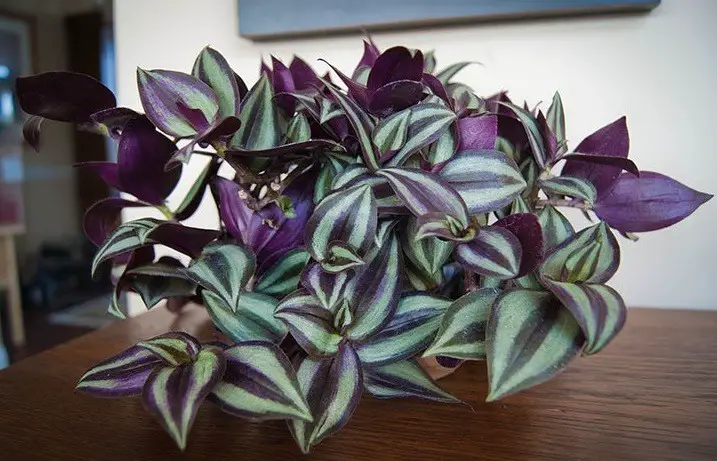Tradescantia zebrina plants are the most beautiful houseplants. These plants cascade down from the hanging baskets or plant stand in all their glory. Tradescantia zebrina losing purple color can be a freaking experience.
So, why are the leaves of my tradescantia zebrina fading? The leading causes are incorrect lighting, the natural aging effect, and nutritional deficiency. Other hidden causes are moisture stress, viral infection, cold draft, and improper soil pH.
I wrote this article to share my experiences about tradescantia zebrina losing purple color. Take the time to read through it and identify the exact causes with their respective solutions. Be sure to read through the tradescantia zebrina yellow leaves under the related questions.
You May Also Read: How to Care for Lipstick Plant

Reasons for Tradescantia Zebrina Leaves Fading
Improper Lighting
Tradescantia zebrina is an eye-catching tropical plant that is easy to grow and thrives in almost any environment with low to bright light.
Tradescantia zebrina leaves fading is due to lack of light. These plants thrive in bright indirect sunlight that makes the stripes more prominent.
Relocate the plant to a region that receives bright indirect sunlight. Prolonged exposure to direct sunlight will result in tradescantia zebrina brown leaves.
Natural Aging Process
Tradescantia zebrina losing purple shades is due to the natural aging process. It would be best to propagate the plant to avoid losing it.
Aging is inevitable regardless of providing ultimate tradescantia zebrina care. Propagation is the only method for reviving the houseplant.
Nutritional Deficiencies
Tradescantia zebrina yellow leaves are signs of nutritional deficiency. It would be best to apply fertilizer and boost the potting soil fertility.
Most tradescantia plants are light feeders when compared to other tropical plants. Exercise precautions when feeding your houseplant.
Overfeeding and underfeeding can also cause tradescantia zebrina to fade. Use either organic or artificial fertilizer to feed the plant.
I recommend feeding tradescantia zebrina during spring and summer. Remember to flush the potting medium every three months to avoid salt buildup.
Moisture Stress
Soil moisture helps tradescantia zebrina plants to stay happy and healthy. Keep the potting soil evenly moist without getting soggy.
Too much moisture causes root rot disease. The condition hinders water uptake around the houseplant in the long run.
Tradescantia zebrina fading is a sign of overwatering. I recommend re-potting the houseplant and trimming the brown patches on the roots.
Use fresh potting soil and a container with drainage holes. These drainage holes at the bottom will help eliminate the excess water and avoid root rot issues.
Dry soil can also make the tradescantia zebrina lose the purple colors. It would be best to soak the soil and rehydrate the houseplant.
Viral Infection
Tradescantia zebrina plants are more vulnerable to viral infection. The condition will show up spreading yellow patches on the leaves. Deformed leaves and stems are other symptoms.
It would be best to isolate the plant to avoid infecting other plants nearby. Use a copper fungicide to treat the viral infection. Remember to wash and sterilize tools after using them.
Cold Draft
Tradescantia zebrina plant thrives in a room temperature environment. The condition enables the plant to stay healthy and happy throughout the year.
Extreme temperature changes will make the houseplant lose its purple color. Both cold and hot drafts can cause harm to your tradescantia zebrina plant.
I recommend keeping the houseplant away from air vents, windowsills, and heaters. It is the best option to prevent your tradescantia zebrina from fading.
Improper Soil pH
Tradescantia zebrina thrives in neutral or slightly acidic soil. Alkaline and acidic soil will make this wandering jew lose its purple color.
Get potting soil with perfect water retention and draining ability. The addition of organic matter will help foster striking foliage colors.
I recommend a mixture of peat, garden soil, organic compost, a light dusting of lime, and perlite. The soil mixture will help to prevent your tradescantia zebrina from fading.
Low Humidity
Tradescantia zebrina thrives in a location with high humidity. The humid environment allows the houseplant to stay happy and healthy throughout the year.
Low humidity is the leading reason behind the tradescantia zebrina losing the purple color. I recommend misting the leaves to increase humidity around the plant.
Use an electric humidifier to boost the indoor humidity instead of misting the leaves. The tradescantia zebrina care tip will help reduce the risk of fungal leaf spot disease.
You May Also Enjoy: How to Care for Heartleaf Philodendron
Related Questions
How Do I Make My Tradescantia More Pink?
Grow your tradescantia zebrina next to a mosaic plant (fittonia albiveins). This trailing plant has deep pink veins in the green foliages. It is a perfect pair for making your tradescantia pinker.
Is Tradescantia Zebrina Toxic to Humans?
Yes. The tradescantia zebrina is mildly toxic to humans and pets. Ingestion might cause mouth and stomach irritation.
Why Is My Tradescantia Zebrina Losing Purple?
Lack of light is the reason behind your tradescantia zebrina losing the bold purple and silver stripes. Relocate the plant to a spot that receives bright indirect sunlight.
You May Also Like: How to Care for Ctenanthe Plant
Final Thoughts
Tradescantia zebrina losing purple color can be due to several reasons. It would be best to diagnose the plant and identify the exact cause before fixing the issue.
Sometimes the tradescantia zebrina fading can be more of a mystery. I recommend changing one thing at a time until you see an improvement in the plant.
I hope the information in this article will help figure the reason behind your tradescantia zebrina losing the bold purple and silver stripe colors.
